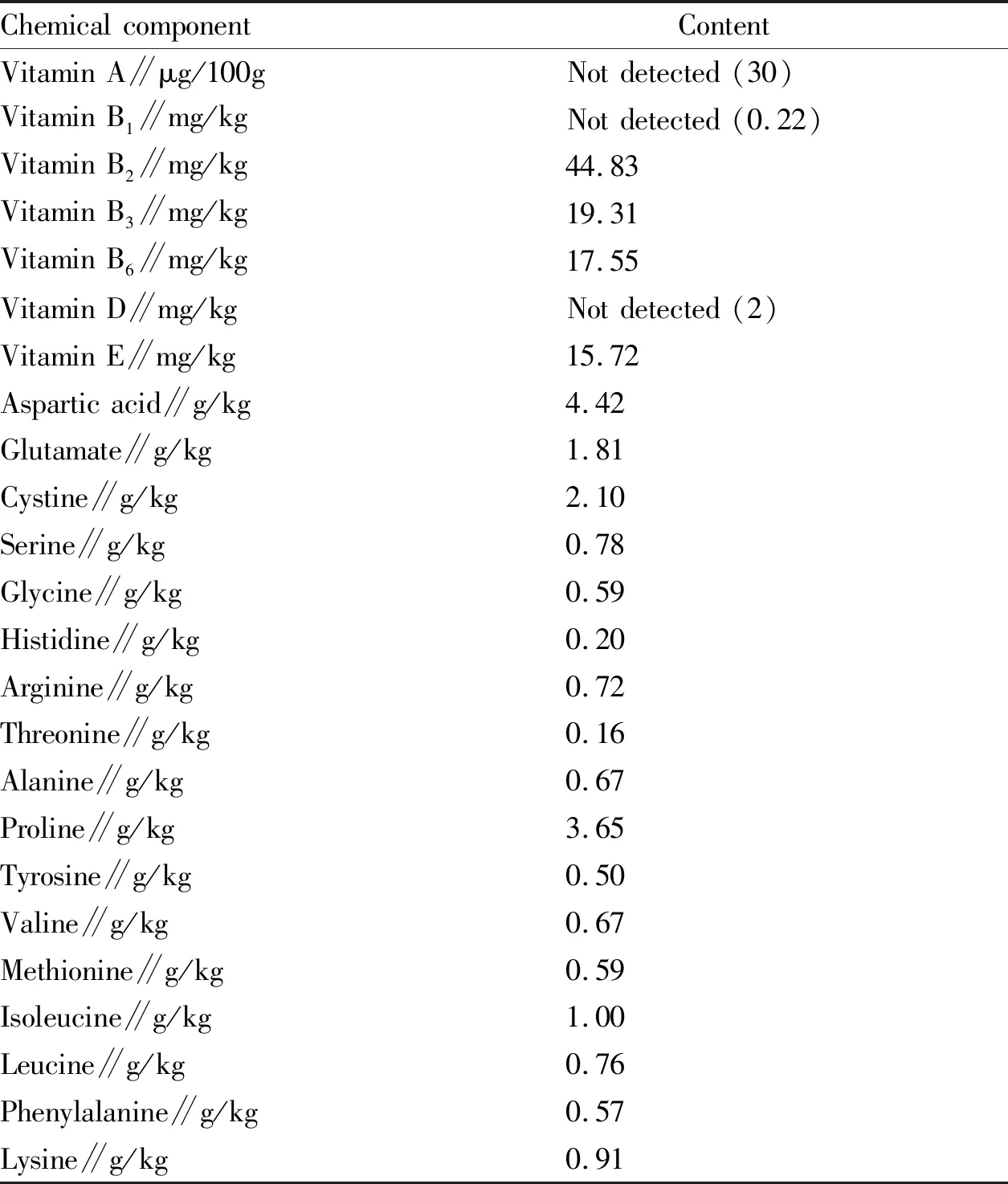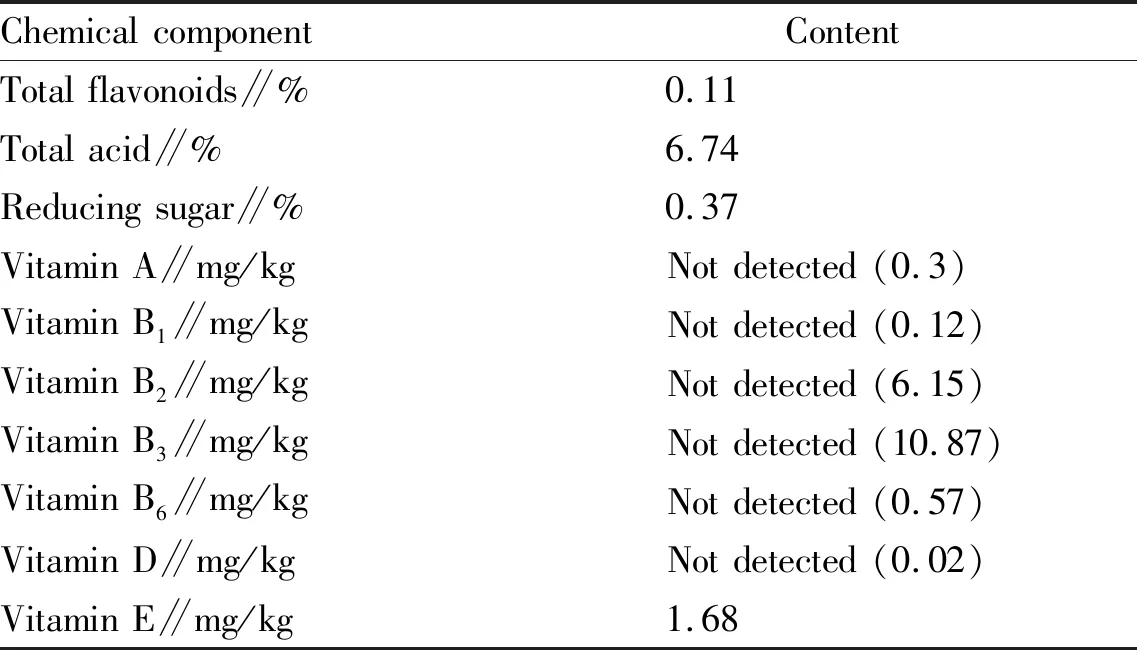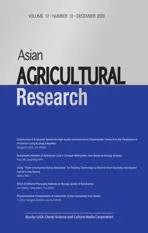Physicochemical Characteristics of Calamondin (Citrus microcarpa) from Hainan
2021-01-26YiZOUHongjianZHANGLianheZHENG
Yi ZOU, Hongjian ZHANG, Lianhe ZHENG*
1. Hainan Institute of Grain and Oil Science, Qionghai 571400, China; 2. Hainan Green Kumquat Food Technology Co., Ltd., Qionghai 571400, China
Abstract Some physicochemical characteristics of calamondin (Citrus microcarpa) from Hainan were determined in this study. The mean length, width, and thickness of calamondin were (2.763±0.262), (2.721±0.189), and (2.684±0.201) cm, respectively. The average values for geometric mean diameter, sphericity, fruit shape index, mass, surface area, volume, true density, bulk density and porosity were (2.721±0.196) cm, (98.79±5.149)%, (101.64±7.609)%, (11.18±2.149) g, (23.36±3.362) cm2, (11.16±2.115) cm3, (1.00±0.060) g/cm3, 0.44 g/cm3, and (56.40±0.027)%, respectively. The mean edible part, juice rate, and soluble solids were (85.77±3.53), (48.36±4.20), and (7.86±0.09)%, respectively. The total flavonoids, pectin, limonin, reducing sugar and volatile oil contents of the peel were 1.00, 7.14, 0.51, 5.98, and 4.25%, respectively. The total flavonoids, pectin, limonin and reducing sugar contents of the pulp were 0.02, 5.04, 0.03 and 4.56%, respectively. The total flavonoids, total acid, reducing sugar and vitamin E contents of the juice were 0.11, 6.74, 0.37%, and 1.68 mg/kg, respectively, while the content of vitamins A, B1, B2, B3, B6, and D in the juice was very low. The seeds had limonin, reducing sugar and oil contents of 0.46, 1.39, and 30.46%, respectively. The vitamin B2, B3, B6 and E contents of the fruit residue were 44.83, 19.31, 17.55, and 15.72 mg/kg, respectively. The amino acid profile of the residue included aspartic acid, glutamate, cystine, serine, glycine, histidine, arginine, threonine, alanine, proline, tyrosine, valine, methionine, isoleucine, leucine, phenylalanine and lysine, with respective contents of 4.42, 1.81, 2.10, 0.78, 0.59, 0.20, 0.72, 0.16 0.67, 3.65 0.50, 0.67, 0.59, 1.00, 0.76, 0.57 and 0.91 g/kg.
Key words Hainan calamondin, Physical characteristic, Chemical characteristic, Nutrient content
1 Introduction
Calamondin (Citrusmicrocarpa) (Rutaceae:Citrus) is an economically important small fruit-bearing citrus tree, and a kumquat hybrid. It has traditionally been consumed in Hainan, China. Calamondin is commonly found in China (known locally as Qingjinju), Malaysia (kasturi lime), Indonesia (jeruk kasturi), Thailand (ma-nao-wan), Philippines (kalamondin, kalamunding, kalamansi, calamansi, limonsito or agridulce), Taiwan, China (gold lime)[1]and other Southeast Asian countries. The trees are typically 2-7.5 m in height and characterized by a spiny or thorny stem, leathery green leaves, and clusters of small aromatic white flowers. The fruit is round and small, with a typical diameter of 2-4 cm, and has a smooth and shiny skin. The unripe fruit is green and becomes yellowish orange upon ripening. The pulp is juicy and orange with a very sour taste, and usually contains numerous seeds[1]. The harvest yield is very high; and according to statistics, the annual output of one calamondin tree is typically 50-100 kg and the yield is 75-120 t/ha. The fruit is predominantly used for juicing and the fruit pulp is discarded as waste after processing, which has led to environmental pollution and wastage of resources.
Calamondin pomace contains an abundance of nutrients, including flavonoids, pectin, and limonin. Flavonoids from various citrus species have known nutritional benefits, particularly antioxidant and anti-inflammatory properties. The flavonoids in the calamondin samples were diosmin (5.99 μg/g), hesperetin (3.31 μg/g), hesperidin (0.42 μg/g), naringin (1.66 μg/g), and quercetin (0.53 μg/g)[2]. Phytosterols are generally dominated by the structure of cholesterol with one or two extra carbon atoms in the side chain. They can inhibit the absorption of endogenous cholesterol, leading to the cholesterol-lowering effect[3]. The calamondin samples contained sitosterol (1.57 μg/g), stigmasterol (4.52 μg/g), campesterol (4.43 μg/g), and amyrin (2.07 μg/g)[2]. Limonins have various nutraceutical properties, including anticancer, antioxidant, antibacterial, and antifungal effects. The calamondin samples were rich in limonins, with a content of 1.85 μg/g[2].
The appealing flavor and high nutritional value of calamondin has led to its use not only as a seasoning, but in the production of processing fruits powders, fruit slices, juice, jam and fruit wine. However, little research into the basic physical properties of calamondin has been previously conducted. Furthermore, there is no specialized mechanical equipment for the harvest and screening of calamondin, and the use of unspecialized equipment greatly reduces production efficiency and hinders the development of the calamondin industry. Therefore, the physical properties of the calamondin need to be studied in detail.
Hainan is a province in South China with a tropical climate suitable for the production of citrus. The only area planted with more than 700 ha of calamondin is Haikou City, which reports an annual output of over 50 000 t. However, the lack of effective mechanical equipment has led to delayed picking and processing, which results in a large amount of waste.
This study aimed to present the first report on the physicochemical characteristic of Hainan calamondin. These findings are expected to contribute to the design of appropriate machinery and promote subsequent in-depth research and product development.
2 Materials and methods
2.1PlantmaterialsFresh calamondin fruits were obtained directly from a vegetable market in Jiaji in Qionghai, Hainan. Samples were washed three times with water to remove dust, leaves, immature fruit and broken fruit, and blow dried at room temperature.
Fruit powder was obtained by separating the processed fresh fruit into peels, seeds, pulp and juice. The seeds, peels and pulp were dried at 50 ℃ and milled by multifunctional food processing machine (js80d-200).
2.2Physicalproperties
2.2.1Geometric mean diameter[4]. The length (L), width (W) and thickness (T) of the fruits were measured using a vernier caliper with a resolution of 0.02 mm. The geometric mean diameter (D) was calculated using formula (1):
D=(LWT)1/3
(1)
2.2.2Sphericity[4]: Sphericity was calculated using formula (2):
(2)
2.2.3Fruit shape index[5]: Fruit shape index was calculated using formula (3):
(3)
2.2.4Surface area[4]: Surface area of the fruit was calculated using formula (4):
Surface area=πD2
(4)
2.2.5True density[4]: The mass (m) of fruit was measured using an electronic balance (±0.01 g) and the volume (v) was measured using the water displacement method. The true density (ρt) was calculated using formula (5):
(5)
2.2.6Bulk density[4]: The bulk density was determined by filling a 250 mL cylindrical container with calamondins and determining the mass (mb). The bulk density (ρb) was calculated using formula (6):
(6)
2.2.7Porosity[4]: Porosity of the fruit was calculated using formula (7):
(7)
2.2.8Edible percentage[5]: All fruit except seeds are edible. A sample of 10-20 fruits was weighed (±0.1 g). The peel (including the white cortex), stalk, seeds and other parts of each fruit were separated and weighed (±0.1 g). The edible percentage was calculated using formula (8):
(8)
wherew′ is the total mass of the whole fruit (g) andw12is the mass of the seeds (g).
2.2.9Juice rate[5]: A sample of 10-20 fruits was weighed (±0.1 g). Each fruit was sliced in two parts, juiced using a juicer and pressed to remove all remaining juice, which was collected in a beaker. The peel, seeds and pomace (including the wall of the sputum and the wall of the juice) were weighed (±0.1 g). The juice rate was calculated using formula (9):
(9)
wherew′ is the total mass of the sample fruit (g),w11is the mass of the peel (g),w12is the mass of the seeds (g) andw14is the mass of the fruit residue (g).
2.2.10Soluble solids[5]: The juice was filtered through two layers of gauze into a beaker and stirred well. A pipette was used to sample 1-2 drops of the juice, which was quickly transferred to the prism of an Abbe Refractometer and rested for a few seconds to reach 20 ℃. The light source was aligned, and the eyepiece was used while rotating the compensator spiral to achieve a clear light and dark boundary line. The scale pointer spiral was rotated to focus the light and dark boundary line on the "×" mark of the objective lens and the ruler. The sugar reading and temperature were recorded, and testing was conducted in duplicate or triplicate to determine a mean value.
2.3Chemicalproperties
2.3.1Determination of total flavonoids[6]. The total flavonoid content of the peel, pulp and juice was determined according to the China Industry Standard for Agriculture:DeterminationofTotalFlavonoidsinCitrusFruitsandDerivedproducts(NY/T2010-2011).
2.3.2Determination of total acid[7]. The total acid of fruit juice was determined according to the National Food Safety Standard:DeterminationofTotalAcidinFoods(GB/T 12456-2008).
2.3.3Determination of pectin[8]. The pectin content of peel, pulp and whole fruit was determined according to the China Industry Standard for Agriculture:DeterminationofPectinContentinFruitandDerivedProducts(SpectrophotometryMethod) (NY/T 2016-2011).
2.3.4Determination of limonin[9]: A limonin standard was formulated in anhydrous ethanol to a standard working solution of 130 μg/mL. Different volumes of the standard solution (0, 0.5, 0.8, 1.2, 1.5, and 2.0 mL) were added to 6 tubes, along with 2.0 mL of absolute ethanol and 5.0 mL of the reaction solution. The reaction solution was obtained by dissolving 125 mg p-dimethylaminobenzaldehyde and 0.5 mL of 0.9% ferric chloride solution in 100 mL of sulfuric acid-anhydrous ethanol mixed solution (Vsulfuric acid∶Vanhydrous ethanol = 35∶65). The mixed solution was shaken and rested for 30 min before taking an absorbance reading at 500 nm. Linear regression was performed to obtain standard curve. 10.0 g of peel and seed powder (accurate to 0.001 g) was placed into petroleum ether as a solvent to completely degrease the samples over 24 h using Soxhlet extraction. Samples were dried, wrapped in filter paper and placed in the Soxhlet extractor. Extraction with acetone solution was conducted for 6 h. The extracted solution was concentrated under low pressure, dissolved in dichloromethane, filtered, concentrated under low pressure second time, dissolved in absolute ethanol and diluted to 25 mL.
1.5 mL of sample preparation solution was diluted to 2.0 mL with absolute ethanol, the absorbance of the sample preparation solution was measured according to the standard curve method, and limonin concentration in the sample preparation solution was determined from the standard curve by the absorbance. The limonin concentration was used to calculate the limonin content according to formula (10):

(10)
whereρis limonin concentration determined using the standard curve (ug/mL),Lis the volume of the sample solution(mL) andMis the sample quality (g).
2.3.5Determination of reducing sugars[10]. The reducing sugar content of the peel, pulp, seeds and juice was determined according to the National Food Safety Standard:DeterminationofReducingSugarsinFoods.
2.3.6Determination of vitamin content[11-15]. The vitamin content of the fruit residue and juice was determined according to the National Food Safety Standard: Determination of vitamins A, D and E in food, vitamin B1in food, vitamin B2in food, vitamin B3(nicotinic acid and nicotinamide) in cosmetics (HPLC and HPLC-MS/MS) and vitamin B6in food.
2.3.7Determination of amino acid content[16]. The amino acid content of the fruit residue was determined according to the National Food Safety Standard:DeterminationofAminoAcidsinFoods.
3 Results and analysis
3.1PhysicalpropertiesofcalamondinfruitThe mass of calamondin varied widely from 7.78 to 15.19 g[mean=(11.18±2.149) g], the volume ranged from 7.50 to 15.85 cm3[mean=(11.16±2.115) cm3]and the fruit ranged from 2.182 to 3.220 cm in length[mean=(2.763±0.262) cm], from 2.400 to 3.054 cm in width[mean=(2.721±0.189) cm], and from 2.100 to 2.980 cm in thickness (Table 1). The calamondin was bigger than the musk lime from Malaysia[1]but smaller than bergamot[17], Valencia oranges, interdonate lemons, red blush grapefruit and satsuma mandarins[18], indicating that the calamondin fruit is one of the smallest members of the citrus family. This insight is very useful when designing systems for the transportation, blanking and processing of the fruit.

Table 1 Physical properties of calamondin
The geometric mean diameter varied from 2.377 to 3.059 cm[mean=(2.721±0.196) cm], while the sphericity and fruit shape index varied from 92.36% to 117.24% and from 75.24% to 112.21%, respectively[mean sphericity=(98.79±5.149)%; mean fruit shape index=(101.64±7.609)%]. This indicated that the shape has a strong tendency toward a sphere and that the fruit has a high probability of rolling during processing.
The mean bulk density was 0.44 g/cm3, while the true density and porosity ranged from 0.83 to 1.10 g/cm3and from 47.44% to 60.34%, respectively[mean true density=(1.00±0.060) g/cm3; mean porosity=(56.40±0.027)%]. Density, true density, bulk density and porosity of calamondin were higher than bergamot[17]but lower than the musk lime from Malaysia[1]. This parameter is important in determining the storage capacity of the fruits, where the small size of the fruit likely contributes to the high bulk density[1].
The edible percentage varied from 74.16% to 91.89 %[mean=(85.77±3.53)%], higher than the navel orange, ponkan and pomelo[19]. The proportion of the fruit’s machinable section was large, which shows promise for reducing processing waste and environmental pollution with further experimental research and comprehensive implementation of specialized strategies.
The juice rate and juice soluble solids content were lower than the navel orange, ponkan and pomelo[19]. As the yield and edible percentage of calamondin is high and the price is low, giving the fruit a high research and processing value.
3.2ChemicalpropertiesofcalamondinpeelThe contents of total flavonoids, pectin, limonin, reducing sugars and volatile oils in the peel were 1.00%, 7.14%, 0.51%, 5.98% and 4.25%, respectively (Table 2). The total flavonoid content of the calamondin peel was higher than ‘Miyagawa Wase’ satsuma mandarin, Quzhou ponkan, ‘Hamlin’ orange, Changshanhuyou tangelo and tonkan[20]but lower than mandarin, lemon and bitter orange[21]. The limonin content of the peel was 2-4 times higher than many citrus fruits, such as lemon, grapefruits, orange and pomelo[22]. While the pectin content was lower than those of other citrus fruits, such as pomelo and mandarin[23].

Table 2 Chemical properties of calamondin peel
3.3ChemicalpropertiesofcalamondinpulpThe contents of total flavonoids, pectin, limonin and reducing sugars in the pulp were 1.02%, 5.04%, 0.03% and 4.56%, respectively (Table 3). The limonin content was higher than many citrus fruits such as lemon, grapefruits, pomelo and orange[22].

Table 6 Some chemical properties of calamondin fruit residue

Table 5 Chemical properties of calamondin seed

Table 4 Chemical properties of calamondin juice

Table 3 Chemical properties of calamondin pulp
3.4ChemicalpropertiesofcalamondinjuiceThe contents of total flavonoids, total acid, reducing sugars and vitamin E in the juice were 0.11%, 6.74%, 0.37% and 1.68 mg/kg, respectively. The total flavonoid content was lower than the kasturi lime[24]. The total acid of the juice was higher than that in calamansi juice from Malaysia, Philippines and Vietnam, while the reducing sugar content was lower[25].
3.5ChemicalpropertiesofcalamondinseedThe contents of limonin, reducing sugars and volatile oils in the seed were 0.46%, 1.39% and 30.46%, respectively. The limonin content was 0.46% and lower than the chrysanthemum core, south orange, Xupu Ordinary Sweet Orange[22]. The oil content of 30.46% was lower than musk lime, tangelo, lime and bitter orange, but higher than grapefruit and tangerine[1].
3.6ChemicalpropertiesofcalamondinfruitresidueThe contents of vitamins B2, B3, B6and E in the fruit residue were 44.83, 19.31, 17.55, and 15.72 mg/kg, respectively. The amino acid profile included aspartic acid, glutamate, cystine, serine, glycine, histidine, arginine, threonine, alanine, proline, tyrosine, valine, methionine, isoleucine, leucine, phenylalanine and lysine contents of 4.42, 1.81, 2.10, 0.78, 0.59, 0.20, 0.72, 0.16, 0.67, 3.65, 0.50, 0.67, 0.59, 1.00, 0.76, 0.57 and 0.91 g/kg ,respectively.
4 Conclusions
The means of length, width and thickness of the calamondin fruits were (2.763±0.262), (2.721±0.189) and (2.684±0.201) cm, respectively. The mean geometric mean diameter, sphericity, fruit shape index, mass, surface area, volume, true density, bulk density and porosity were (2.721±0.196) cm, (98.79±5.149)%, (101.64±7.609)%, (11.18±2.149) g, (23.36±3.362) cm2,(11.16±2.115) cm3, (1.00±0.060) g/cm3, 0.44 g/cm3and (56.40±0.027)%, respectively. The mean edible percentage, juice rate and soluble solids contents were (85.77±3.53)%, (48.36±4.20)% and (7.86±0.09)%, respectively.
The total flavonoid, pectin, limonin, reducing sugar and volatile oil contents of the peel were 1.00%, 7.14%, 0.51%, 5.98% and 4.25%, respectively. The total flavonoid, pectin, limonin and reducing sugar contents of the pulp were 1.02%, 5.04%, 0.03% and 4.56%, respectively. The total flavonoid, total acid, reducing sugar and vitamin E contents of the juice were 0.11%, 6.74%, 0.37% and 1.68 mg/kg, respectively, while the content of vitamins A, B1, B2, B3, B6and D was very low. The limonin, reducing sugar and volatile oil contents of the seed were 0.46%, 1.39% and 30.46%, respectively. The vitamin B2, B3, B6, and E contents of the fruit residue were 44.83, 19.31, 17.55, and 15.72 mg/kg, respectively. The amino acid profile of the residue included aspartic acid, glutamate, cystine, serine, glycine, histidine, arginine, threonine, alanine, proline, tyrosine, valine, methionine, isoleucine, leucine, phenylalanine and lysine contents of 4.42, 1.81, 2.10, 0.78, 0.59, 0.20, 0.72, 0.16, 0.67, 3.65, 0.50, 0.67, 0.59, 1.00, 0.76, 0.57 and 0.91 g/kg, respectively.
The technical data obtained in this study can be used to further improve the study and processing of calamondins, and to aid the development of specialized harvesting and processing equipment. The chemical properties of the peel, pulp, juice and seeds further research and value-added product development focused on the calamondin fruit.
杂志排行
Asian Agricultural Research的其它文章
- Genome-wide Association Analysis of Maize Flowering Traits
- Effect of Different Processing Methods on Storage Quality of Strawberries
- Using "Three-dimensional Space Resources" for Fenlong Technology to Improve Grain Econoloy and Expand Human Living Spaces
- Construction of Evaluation System for High-quality Development of Characteristic Towns from the Perspective of Production-Living-Ecology Integration
- Analysis on Problem of Rural Surplus Labor and Recommendations for Rural Labor Transfer
- Protection and Development of Traditional Villages from the Perspective of Territorial Spatial Planning: Taking Baisi Village, Henan Province as an Example
